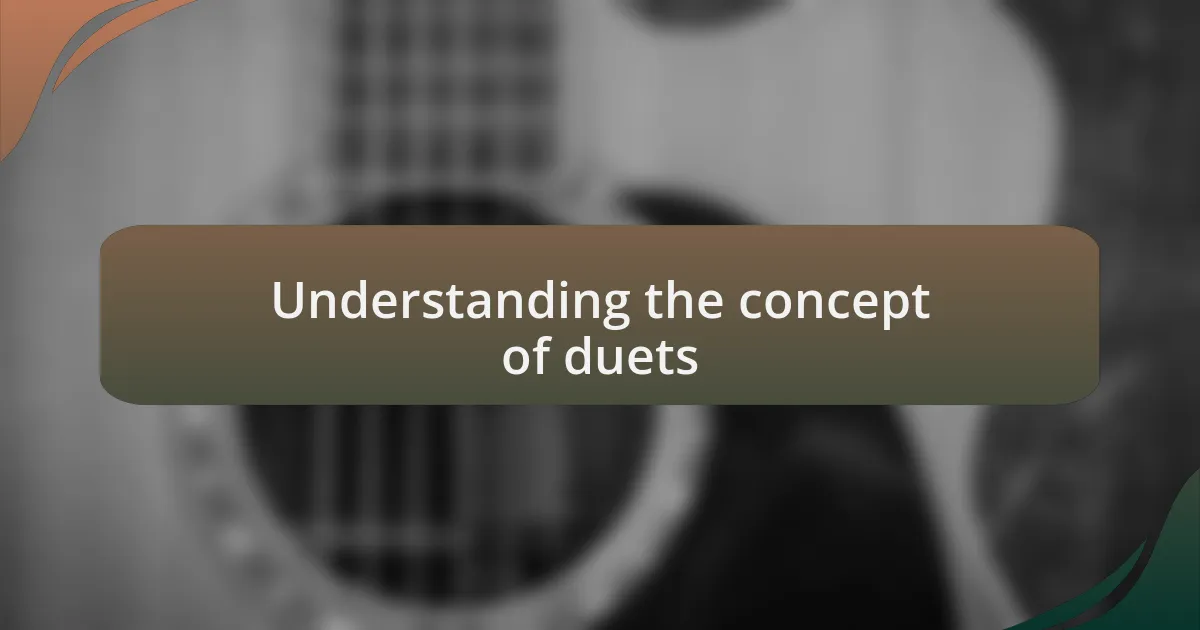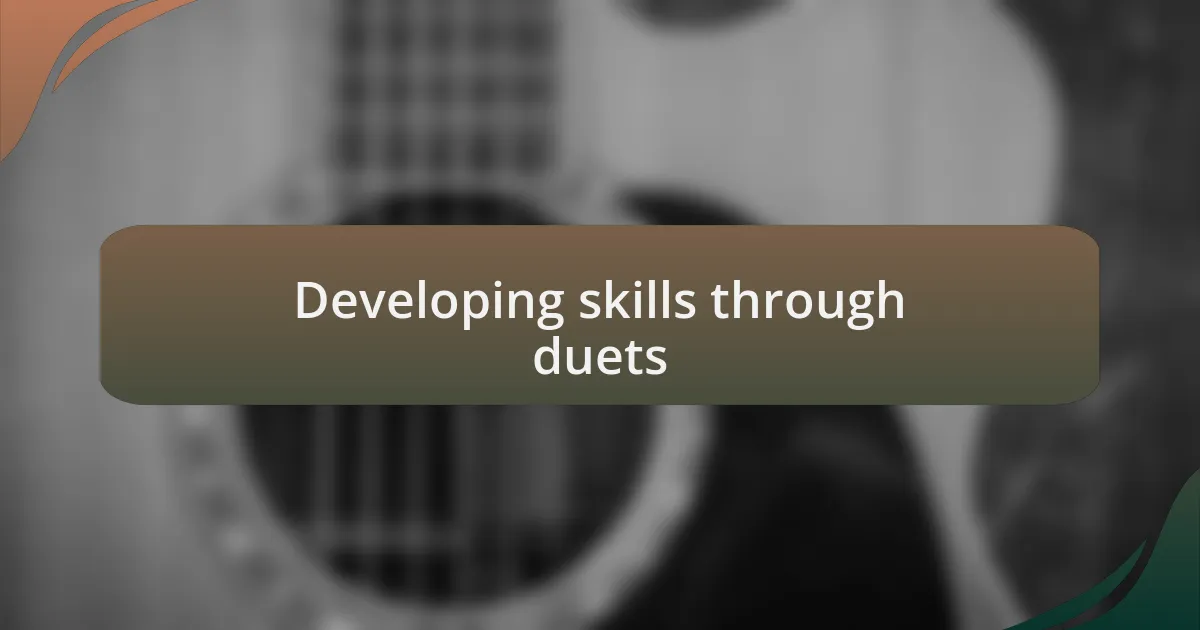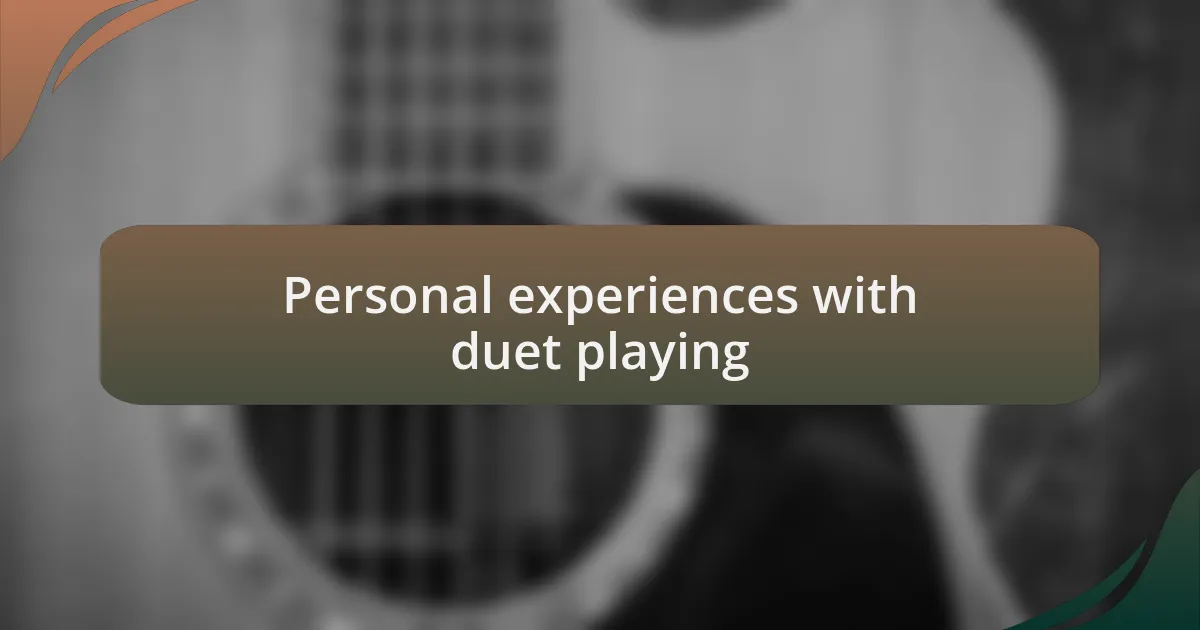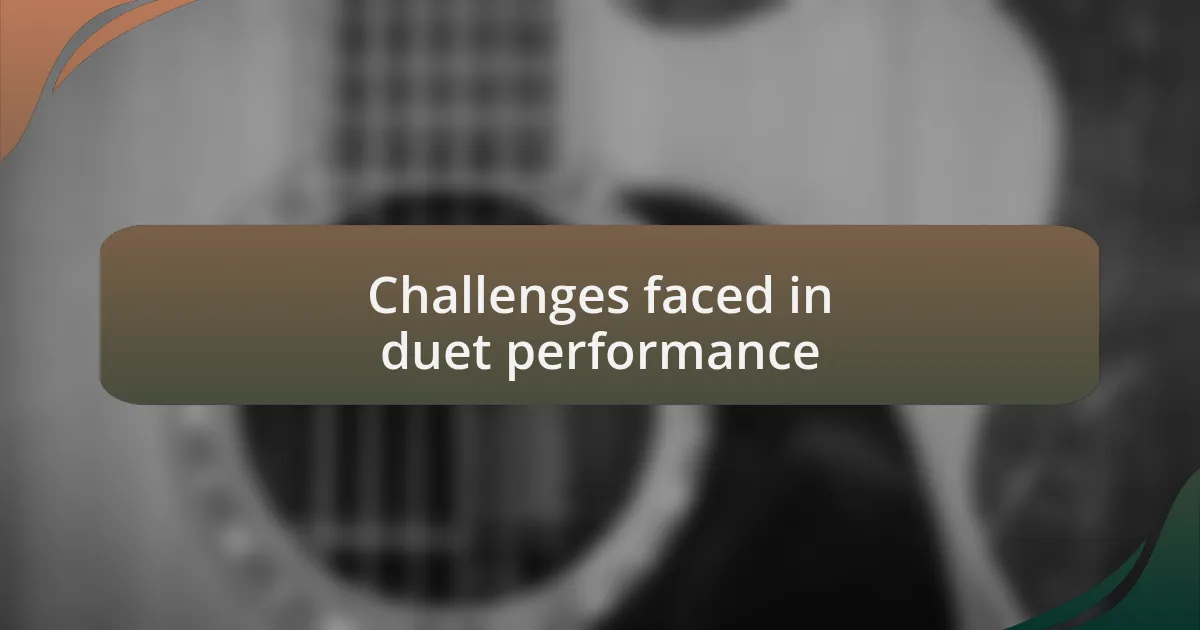Key takeaways:
- A duet is a musical dialogue that fosters emotional connections and enhances listening skills between musicians.
- Playing duets nurtures confidence, technical skills, and timing through collaboration and shared accountability.
- Challenges in duet performance include synchronization issues, interpretative differences, and the balance of musical presence.
- Successful collaboration requires clear communication, active listening, and flexibility during practice to create a harmonious performance.

Understanding the concept of duets
When I think about the essence of a duet, I see it as a beautiful dialogue between two musicians. Each player has a unique voice, yet they come together to create something richer and more profound than either could achieve alone. Have you ever felt that spark when harmonies blend? It’s like a conversation that flows effortlessly.
Duets can vary widely; they may be structured or improvised, serious or playful. I recall one unforgettable evening when my friend and I spontaneously played a duet in an empty hall. The notes danced around us, forming a connection that words could never replicate. Isn’t it fascinating how two instruments can speak in such harmony?
Ultimately, the beauty of a duet lies in its interplay. It’s about listening and responding, much like a relationship. In those moments, I’ve experienced a deep emotional connection—not just to the music, but to my partner as well. Can you think of a time when playing with someone else evoked a similar sense of unity for you?

Benefits of playing duets
Playing duets offers a unique opportunity to develop listening skills. When I play alongside another musician, I find myself tuning in more acutely to their phrasing and timing. This heightened awareness enhances not only our performance but also my ability to connect with others in various musical settings. Have you ever noticed how your playing improves when you focus on someone else’s cues?
Another significant benefit is the shared joy that comes from making music together. I remember a time when I collaborated with a fellow musician to prepare for a local concert. Each rehearsal felt like an exciting adventure, filled with laughter and unexpected moments of brilliance. Isn’t it amazing how that camaraderie can transform practice into something fun and memorable?
Finally, playing duets can nurture confidence as musicians learn to express themselves in tandem with others. I’ve experienced moments of uncertainty, especially when tackling challenging pieces, but having a duet partner by my side made facing those hurdles feel less daunting. Isn’t it empowering to know that you’re not alone in your musical journey? This support fosters resilience and ultimately leads to personal growth for both players.

Developing skills through duets
Playing duets significantly enhances technical skills through collaboration and shared accountability. I remember struggling with the intricacies of a difficult passage during a rehearsal with a fellow flutist. By working together, not only did I pick up their finger positions, but I also discovered new ways to phrase the music. Isn’t it incredible how two minds can unlock a piece in ways that solo practice often can’t?
The aspect of timing in duets can’t be overstated. When I practice with another musician, I become acutely aware of how much rhythm can sway and shift. I always recall one particular session where my partner’s pulse pushed me to play more expressively. That push taught me not only about maintaining steady tempos but also about finding my own musical voice within the structure. Have you ever realized how the act of listening to another can remarkably refine your own timing?
Communication is also a key skill honed through duet playing. Each time I perform with someone else, I find myself experimenting with subtle gestures to convey musical ideas. I felt a sense of triumph during a performance where a simple nod transformed our interpretation into something magical. How often can you say that a fleeting moment of connection elevates a piece beyond notes on a page? That’s the beauty of shared musicality!

Personal experiences with duet playing
There was a time when I partnered with a close friend for a piano duet, and it felt like a dance. Each note we played together seemed to draw us closer, almost creating a bond through music. I remember how our laughter during rehearsals made even the trickiest sections feel light and achievable. Wasn’t it fascinating how the joy of shared effort turned our practice sessions into memorable experiences?
One evening, we decided to play a piece we’d never tackled before. I felt a rush of excitement and a tinge of anxiety as we dove in. The blend of our two sounds was mesmerizing, but it required constant adjustment to ensure we were in sync. It was a reminder of the delicate balance needed in duet playing—an experience that taught me vulnerability and trust. How often do we get the chance to grow through unpredictability with someone else by our side?
In another instance, I had the pleasure of collaborating with a cellist. I found that playing in harmony forced me to really listen—not just to the music, but to the emotions conveyed through each phrase. There was a moment when I played a softer passage, and I could feel their tension easing into a shared calm. Isn’t it remarkable how music can become a conversation where each note bridges our feelings and experiences? This level of connection has made duet playing one of my favorite ways to express myself musically.

Challenges faced in duet performance
When engaging in duet performance, one of the notable challenges is the necessity for synchronization. I vividly recall a session where my partner and I struggled with timing. It was frustrating to feel like we were always just a heartbeat off, leading me to question whether we’d ever find that perfect groove together. Have you ever felt that tension in a performance?
Another hurdle is the emotional and interpretative differences between partners. I remember collaborating with a violinist who approached a piece with a passionate intensity that contrasted with my more measured style. To find a common musical language, we had to communicate openly about how each of us envisioned the piece. How do you bridge those interpretative gaps when playing with someone whose style differs from yours?
Lastly, managing the balance of play can be a tricky task in duets. I once played with a more experienced musician who tended to dominate the sound, making it difficult for me to assert my voice. I learned this was not just about volume but about musical presence. How do you make your voice heard without overpowering your partner? It’s a delicate dance that enhances the learning experience, pushing both partners to be more aware and considerate.

Tips for successful duet collaboration
When collaborating on a duet, clear communication is essential. I once had a rehearsal that transformed from chaos to harmony simply by discussing our creative intentions before we played. How often do we underestimate the power of expressing our thoughts? Taking a few minutes to align our visions can make all the difference in achieving a unified sound.
Listening actively to your partner is another crucial tip. I recall a performance where I was so focused on my part that I missed the subtle nuances my pianist was bringing to the piece. It wasn’t until we talked afterward that I realized how our interplay could have soared had I nestled more into the texture of the accompaniment. Have you ever found yourself wrapped up in your own music, overlooking those beautiful moments created in collaboration?
Lastly, embracing flexibility during practice leads to stronger duet performances. During one session, my partner suggested we shift tempos on a particular passage; I hesitated but decided to give it a try. It opened up an entirely new interpretation of the piece that resonated deeply with both of us. Have you felt that exhilarating moment when a spontaneous adjustment transforms the music? Being adaptable not only enhances the performance but also strengthens the bond between duet partners.